Posted on June 19th, 2011 by Mary Lord
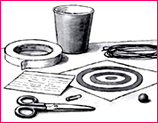 In this lesson, teams of students in grades 6 to 12 will explore the engineering design process by modifying a paper cup to carry a marble down a zip line and drop it precisely on a target. They will learn to brainstorm, test, evaluate, and redesign their devices to improve accuracy and effectiveness of the remote-release mechanism.
In this lesson, teams of students in grades 6 to 12 will explore the engineering design process by modifying a paper cup to carry a marble down a zip line and drop it precisely on a target. They will learn to brainstorm, test, evaluate, and redesign their devices to improve accuracy and effectiveness of the remote-release mechanism.
Read More
Filed under: Grades 6-8, Grades 9-12, Lesson Plans | 2 Comments »
Tags: Class Activities, Grades 6-8, Grades 9-12, Lesson Plan, Mechanical engineering, Physics, zip line
Posted on June 5th, 2011 by Mary Lord
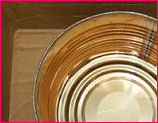 Student teams in grades 9-11 gain a better understanding of heat transfer and engineering by designing and building solar water-heating devices that mimic those used in residences. Once the model devices are constructed, students perform efficiency calculations and compare designs.
Student teams in grades 9-11 gain a better understanding of heat transfer and engineering by designing and building solar water-heating devices that mimic those used in residences. Once the model devices are constructed, students perform efficiency calculations and compare designs.
Read More
Filed under: Grades 6-8, Grades 9-12, Grades K-5, Lesson Plans | Comments Off on Lesson: Solar Water Heater
Tags: Energy and Environmental Technology, Environmental Engineering, Environmental science, Grades 9-12, Green, Green Technology, Lesson Plans, Solar Energy, Solar Engineering
Posted on May 22nd, 2011 by Mary Lord
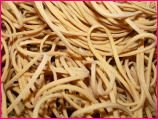 In this activity, teams of students 8 – 18 learn about engineering design by constructing rubber-band-powered cars from everyday materials that can travel in a straight line for a distance of at least 3 meters within a 1 meter wide track. They test their rubber-band racers, evaluate their results, and present to the class.
In this activity, teams of students 8 – 18 learn about engineering design by constructing rubber-band-powered cars from everyday materials that can travel in a straight line for a distance of at least 3 meters within a 1 meter wide track. They test their rubber-band racers, evaluate their results, and present to the class.
Read More
Filed under: Grades 6-8, Grades K-5, Lesson Plans | 2 Comments »
Tags: Class Activities, force, Grades 6-8, Grades K-5, Lesson Plan, Lesson Plans, motion, Physics, propulsion, rubber band racers
Posted on May 11th, 2011 by Mary Lord
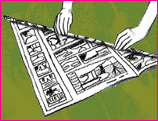 In this lesson, students in grades 4-7 explore the engineering design process by building a table out of tubes of newspaper that is strong enough to hold a heavy book. They learn to brainstorm, test, evaluate, and redesign their tables to support more weight and figure out how to keep the table legs from buckling.
In this lesson, students in grades 4-7 explore the engineering design process by building a table out of tubes of newspaper that is strong enough to hold a heavy book. They learn to brainstorm, test, evaluate, and redesign their tables to support more weight and figure out how to keep the table legs from buckling.
Read More
Filed under: Grades 6-8, Grades K-5, Lesson Plans | Comments Off on Lesson: Design a Sturdy Paper Table
Tags: Building Design, Design, Design Squad, Engineering Design, Engineering Design Process, Lesson Plan, PBS, PBS programs, Videos
Posted on May 8th, 2011 by ASEE
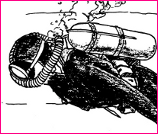 Scuba diving is an excellent hobby for underwater naturalists. In this lesson, students in grades 6-8 learn about the concepts of buoyancy and how organisms float, sink, or hover in water as they construct a neutrally buoyant “scuba diver.”
Scuba diving is an excellent hobby for underwater naturalists. In this lesson, students in grades 6-8 learn about the concepts of buoyancy and how organisms float, sink, or hover in water as they construct a neutrally buoyant “scuba diver.”
Read More
Filed under: Grades 6-8, Lesson Plans | Comments Off on Lesson: Construct a Buoyant Scuba Diver
Tags: Grades 6-8, Lesson Plan, Marine engineering, Marine Science, Ocean, Ocean science
Posted on May 1st, 2011 by Mary Lord
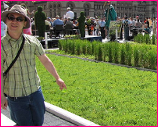 This lesson for grades 6-8 explores how civil engineering has solved the challenge of moving water via irrigation. Students learn how irrigation systems direct water for use in farming or other purposes. Using everyday items, each team of students designs and builds an “irrigation system” capable of moving two cups of water at least three feet and distributing it evenly in two separate containers.
This lesson for grades 6-8 explores how civil engineering has solved the challenge of moving water via irrigation. Students learn how irrigation systems direct water for use in farming or other purposes. Using everyday items, each team of students designs and builds an “irrigation system” capable of moving two cups of water at least three feet and distributing it evenly in two separate containers.
Read More
Filed under: Grades 6-8, Lesson Plans | 1 Comment »
Tags: Class Activities, Environmental Engineering, Environmental science, Grades 6-8, Green, Lesson Plan
Posted on April 17th, 2011 by ASEE
 In this lesson, students in grades 6-12 learn how to make a graph to measure average velocity and calculate the mid-times for personal intervals of student runs, walks, and jogs. Working in groups, one member walks, jogs, or runs in a straight-line path while attempting to maintain a constant velocity. The other group members time the runner along the path, and then record and graph the data of each run.
In this lesson, students in grades 6-12 learn how to make a graph to measure average velocity and calculate the mid-times for personal intervals of student runs, walks, and jogs. Working in groups, one member walks, jogs, or runs in a straight-line path while attempting to maintain a constant velocity. The other group members time the runner along the path, and then record and graph the data of each run.
Read More
Filed under: Grades 6-8, Grades 9-12, Lesson Plans | Comments Off on Lesson: Measuring Velocity
Tags: Class Activities, Grades 6-12, Lesson Plan, Mathematics
Posted on April 10th, 2011 by ASEE
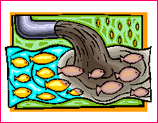 By building a simple watershed with paper and markers, students will understand how pollution accumulates in our water sources, especially from pesticides used in agriculture, and what constitutes a watershed.
By building a simple watershed with paper and markers, students will understand how pollution accumulates in our water sources, especially from pesticides used in agriculture, and what constitutes a watershed.
Read More
Filed under: Grades 6-8, Grades 6-8, Grades K-5, Grades K-5, Lesson Plans | Comments Off on Lesson Plan: Pollution in Our Watershed
Tags: Earth Science, Environmental science, Grades 2-8, water cycle, watershed
Posted on April 3rd, 2011 by Mary Lord
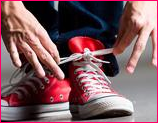 In this activity, students will explore how sensing is part of robotics by tying their shoes with different constraints. After lacing their shoes normally, try it wearing thick gloves or with popsicle sticks taped to fingers so they can’t bend. Can students tie their shoes now? A connection is made to the limitations of the motion of robots, and to the role of design in allowing robots to perform different functions.
In this activity, students will explore how sensing is part of robotics by tying their shoes with different constraints. After lacing their shoes normally, try it wearing thick gloves or with popsicle sticks taped to fingers so they can’t bend. Can students tie their shoes now? A connection is made to the limitations of the motion of robots, and to the role of design in allowing robots to perform different functions.
Read More
Filed under: Grades 6-8, Grades 9-12, Grades K-5, Lesson Plans | Comments Off on 1, 2, Robot Hands Please Tie My Shoe
Tags: Class Activities, Lesson Plan, Museums, Robotics, Science
 In this lesson, teams of students in grades 6 to 12 will explore the engineering design process by modifying a paper cup to carry a marble down a zip line and drop it precisely on a target. They will learn to brainstorm, test, evaluate, and redesign their devices to improve accuracy and effectiveness of the remote-release mechanism.
In this lesson, teams of students in grades 6 to 12 will explore the engineering design process by modifying a paper cup to carry a marble down a zip line and drop it precisely on a target. They will learn to brainstorm, test, evaluate, and redesign their devices to improve accuracy and effectiveness of the remote-release mechanism.








 Student teams in grades 9-11 gain a better understanding of heat transfer and engineering by designing and building solar water-heating devices that mimic those used in residences. Once the model devices are constructed, students perform efficiency calculations and compare designs.
Student teams in grades 9-11 gain a better understanding of heat transfer and engineering by designing and building solar water-heating devices that mimic those used in residences. Once the model devices are constructed, students perform efficiency calculations and compare designs. In this activity, teams of students 8 – 18 learn about engineering design by constructing rubber-band-powered cars from everyday materials that can travel in a straight line for a distance of at least 3 meters within a 1 meter wide track. They test their rubber-band racers, evaluate their results, and present to the class.
In this activity, teams of students 8 – 18 learn about engineering design by constructing rubber-band-powered cars from everyday materials that can travel in a straight line for a distance of at least 3 meters within a 1 meter wide track. They test their rubber-band racers, evaluate their results, and present to the class. In this lesson, students in grades 4-7 explore the engineering design process by building a table out of tubes of newspaper that is strong enough to hold a heavy book. They learn to brainstorm, test, evaluate, and redesign their tables to support more weight and figure out how to keep the table legs from buckling.
In this lesson, students in grades 4-7 explore the engineering design process by building a table out of tubes of newspaper that is strong enough to hold a heavy book. They learn to brainstorm, test, evaluate, and redesign their tables to support more weight and figure out how to keep the table legs from buckling. Scuba diving is an excellent hobby for underwater naturalists. In this lesson, students in grades 6-8 learn about the concepts of buoyancy and how organisms float, sink, or hover in water as they construct a neutrally buoyant “scuba diver.”
Scuba diving is an excellent hobby for underwater naturalists. In this lesson, students in grades 6-8 learn about the concepts of buoyancy and how organisms float, sink, or hover in water as they construct a neutrally buoyant “scuba diver.” This lesson for grades 6-8 explores how civil engineering has solved the challenge of moving water via irrigation. Students learn how irrigation systems direct water for use in farming or other purposes. Using everyday items, each team of students designs and builds an “irrigation system” capable of moving two cups of water at least three feet and distributing it evenly in two separate containers.
This lesson for grades 6-8 explores how civil engineering has solved the challenge of moving water via irrigation. Students learn how irrigation systems direct water for use in farming or other purposes. Using everyday items, each team of students designs and builds an “irrigation system” capable of moving two cups of water at least three feet and distributing it evenly in two separate containers. In this lesson, students in grades 6-12 learn how to make a graph to measure average velocity and calculate the mid-times for personal intervals of student runs, walks, and jogs. Working in groups, one member walks, jogs, or runs in a straight-line path while attempting to maintain a constant velocity. The other group members time the runner along the path, and then record and graph the data of each run.
In this lesson, students in grades 6-12 learn how to make a graph to measure average velocity and calculate the mid-times for personal intervals of student runs, walks, and jogs. Working in groups, one member walks, jogs, or runs in a straight-line path while attempting to maintain a constant velocity. The other group members time the runner along the path, and then record and graph the data of each run. By building a simple watershed with paper and markers, students will understand how pollution accumulates in our water sources, especially from pesticides used in agriculture, and what constitutes a watershed.
By building a simple watershed with paper and markers, students will understand how pollution accumulates in our water sources, especially from pesticides used in agriculture, and what constitutes a watershed.  In this activity, students will explore how sensing is part of robotics by tying their shoes with different constraints. After lacing their shoes normally, try it wearing thick gloves or with popsicle sticks taped to fingers so they can’t bend. Can students tie their shoes now? A connection is made to the limitations of the motion of robots, and to the role of design in allowing robots to perform different functions.
In this activity, students will explore how sensing is part of robotics by tying their shoes with different constraints. After lacing their shoes normally, try it wearing thick gloves or with popsicle sticks taped to fingers so they can’t bend. Can students tie their shoes now? A connection is made to the limitations of the motion of robots, and to the role of design in allowing robots to perform different functions.